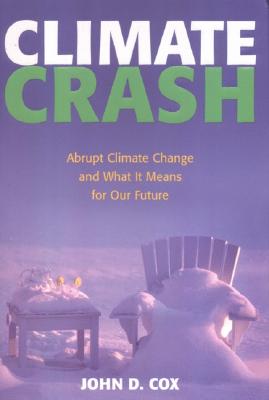

| CLIMATE CRASH Abrupt Climate Change and What It Means for Our Future John D. Cox Washington, DC: Joseph Henry Press, 2005 |
Rating: 5.0 High |
|||
| ISBN-13 978-0-309-09312-5 | ||||
| ISBN 0-309-09312-0 | 215pp. | HC/GSI | $22.95 | |
Veteran journalist John D. Cox has written a competent layman's account of the history of climate science and its implications for our modern world. Without getting bogged down in technicalities, he describes the discoveries made through patient and painstaking examination of cores drilled from Greenland ices and deep-sea sediments.
Getting good cores was the big hurdle. It meant, first of all, knowing where to look. Alfred Wegener, the discoverer of continental drift, gave his life to that effort in Greenland. Next came the logistical problems of drilling deep enough into the ice and removing the cores without ruining their data in the process. After all that was in hand — and it took about fifty years — came the chance to tease out some discoveries. Those discoveries involve the application of radioisotope dating, isotope-ratio analyses to determine the temperature of each layer when it formed, cataloguing pollen grains, measurements of carbon-dioxide concentrations in trapped air bubbles, and other scientific techniques. Computer modeling, too, has an important role to play, even though its results do not yet mimic the actual data. The picture that's emerging is of a series of slow descents into ice ages, each lasting about 100,000 years, interspersed with relatively rapid warming. Warm periods last roughly 10,000 to 20,000 years, and are punctuated by even more rapid drops in temperature of about halfway to the typical ice-age level and back. Current thinking is that these last excursions are tied to disruption of the Gulf Stream circulation, but there's still a lot of uncertainty about that. One thing that is certain is that New York City is not going to freeze solid over a week or two, as the movie The Day After Tomorrow depicted.1
In short, this is an easy to read book that conveys a lot of new information. It does throw a lot of names at you; but there is a good index that lets you trace each scientist's contribution. The one thing I disliked is the poor quality of the figures. Most of them are drawn from the National Research Council's 2002 report Abrupt Climate Change, and I think digging that up to view the originals would be worthwhile. You can find the full citation in Cox's Further Reading list, along with 20 other entries.

 To contact Chris Winter, send email to this address.
To contact Chris Winter, send email to this address.